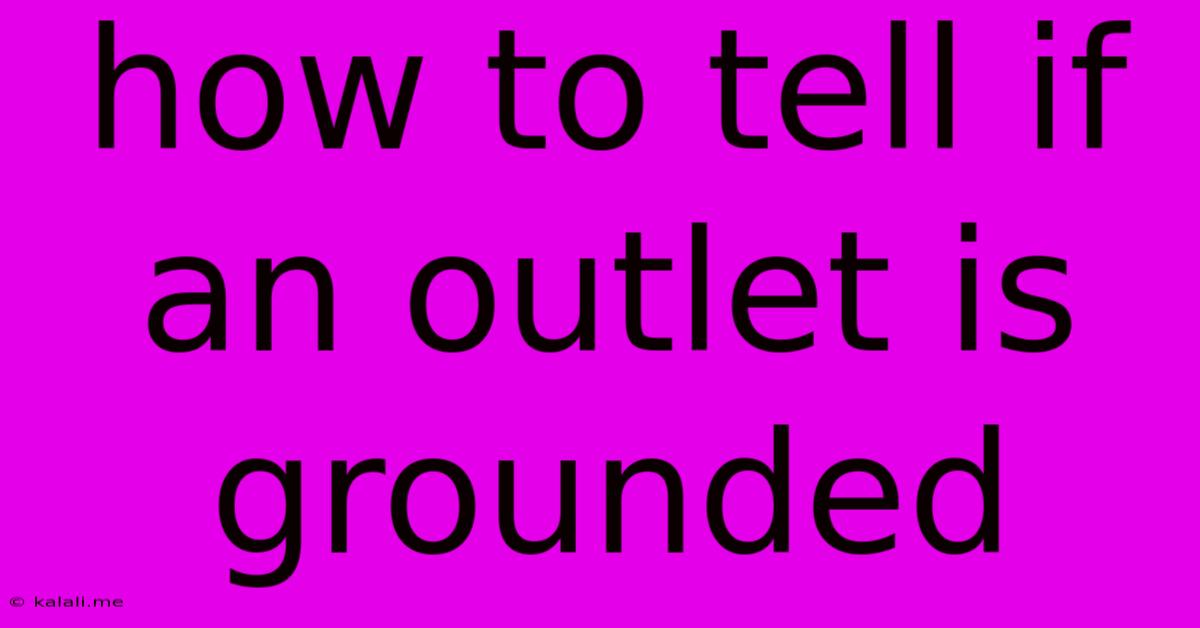How To Tell If An Outlet Is Grounded
Kalali
Jun 01, 2025 · 3 min read

Table of Contents
How to Tell if an Outlet is Grounded: A Comprehensive Guide
Meta Description: Unsure if your electrical outlet is properly grounded? This guide provides simple, safe methods to check your outlets and ensure electrical safety in your home. Learn how to identify grounded outlets and what to do if you find one that isn't.
Electrical safety is paramount in any home. A properly grounded outlet is crucial for preventing electric shocks and protecting your valuable electronics. But how can you tell if an outlet is actually grounded? This article will guide you through several methods to check your home's outlets and ensure your safety.
Understanding Grounding
Before we delve into the methods, let's briefly explain why grounding is important. Grounding provides a safe path for stray electrical current to flow back to the earth, preventing dangerous voltage buildup that can lead to electric shock. A properly grounded outlet has three prongs: two for hot and neutral wires, and one for the ground wire. This ground wire is typically connected to a metal ground rod driven into the earth.
Visual Inspection: The First Step
The easiest method is a visual inspection. Look closely at the outlet itself:
- Three Prongs: A grounded outlet will have three slots: two vertical slots (one wider than the other) and a round hole at the bottom. This round hole is for the grounding pin. If it only has two slots, it's not grounded.
- Grounding Screw: Some outlets have a green grounding screw visible on the faceplate. This screw provides an additional point of connection for the ground wire. Its presence suggests a grounded outlet, but doesn't guarantee it.
- Grounding Symbol: Check for a small symbol of a triangle containing a sideways "U" shape, this indicates a grounding connection.
Important Note: A visual inspection only provides a preliminary assessment. It's not foolproof and doesn't guarantee proper grounding.
Using a Non-Contact Voltage Tester
A non-contact voltage tester is a handy tool for electrical work. It detects the presence of voltage without direct contact, making it safe to use. To check if your outlet is grounded:
- Turn off the power: Always turn off the power to the circuit at the breaker box before testing.
- Test the Hot and Neutral Slots: Touch the tester to each of the vertical slots. It should indicate the presence of voltage.
- Test the Grounding Slot: Touch the tester to the grounding hole (round slot). A properly grounded outlet should show no voltage in this slot. The presence of voltage indicates a potential grounding issue.
This method provides a more reliable check than visual inspection alone.
Using a Grounding Outlet Tester
A specialized grounding outlet tester provides a more comprehensive check of the outlet's wiring. These testers often include LEDs that light up to indicate the status of hot, neutral, and ground wires. They often indicate potential problems like open grounds, reverse polarity, and other wiring issues beyond simply identifying a missing ground. Follow the manufacturer's instructions for using this device.
What to Do if Your Outlet Isn't Grounded
If you find an ungrounded outlet, do not attempt to fix it yourself unless you are a qualified electrician. Improper wiring can lead to serious electrical hazards. Contact a licensed electrician to assess the situation and perform the necessary repairs. They'll ensure the outlet is properly grounded and that your home's electrical system is safe.
Addressing ungrounded outlets is crucial for preventing electrical shocks and fire hazards. Regularly checking your outlets is a simple yet essential step in maintaining a safe home environment.
Latest Posts
Latest Posts
-
How To Use Catagories In Gmail
Jun 02, 2025
-
How Often Should You Replace A Water Heater
Jun 02, 2025
-
What Is A Red Wire For Light Switch
Jun 02, 2025
-
How To Present A Beamer Presentation
Jun 02, 2025
-
How To Install A Gas Dryer
Jun 02, 2025
Related Post
Thank you for visiting our website which covers about How To Tell If An Outlet Is Grounded . We hope the information provided has been useful to you. Feel free to contact us if you have any questions or need further assistance. See you next time and don't miss to bookmark.